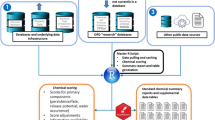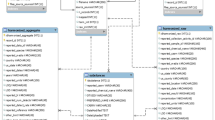Abstract
A National Human Exposure Assessment Survey (NHEXAS) was performed in U.S. Environmental Protection Agency (U.S. EPA) Region V, providing population-based exposure distribution data for metals and volatile organic chemicals (VOCs) in personal, indoor, and outdoor air, drinking water, beverages, food, dust, soil, blood, and urine. One of the principal objectives of NHEXAS was the testing of protocols for acquiring multimedia exposure measurements and developing databases for use in exposure models and assessments. Analysis of the data quality is one element in assessing the performance of the collection and analysis protocols used in NHEXAS. In addition, investigators must have data quality information available to guide their analyses of the study data. At the beginning of the program quality assurance (QA) goals were established for precision, accuracy, and method quantification limits. The assessment of data quality was complicated. First, quality control (QC) data were not available for all analytes and media sampled, because some of the QC data, e.g., precision of duplicate sample analysis, could be derived only if the analyte was present in the media sampled in at least four pairs of sample duplicates. Furthermore, several laboratories were responsible for the analysis of the collected samples. Each laboratory provided QC data according to their protocols and standard operating procedures (SOPs). Detection limits were established for each analyte in each sample type. The calculation of the method detection limits (MDLs) was different for each analytical method. The analytical methods for metals had adequate sensitivity for arsenic, lead, and cadmium in most media but not for chromium. The QA goals for arsenic and lead were met for all media except arsenic in dust and lead in air. The analytical methods for VOCs in air, water, and blood were sufficiently sensitive and met the QA goals, with very few exceptions. Accuracy was assessed as recovery from field controls. The results were excellent (≥98%) for metals in drinking water and acceptable (≥75%) for all VOCs except o-xylene in air. The recovery of VOCs from drinking water was lower, with all analytes except toluene (98%) in the 60–85% recovery range. The recovery of VOCs from drinking water also decreased when comparing holding times of <8 and >8 days. Assessment of the precision of sample collection and analysis was based on the percent relative standard deviation (% RSD) between the results for duplicate samples. In general, the number of duplicate samples (i.e., sample pairs) with measurable data were too few to assess the precision for cadmium and chromium in the various media. For arsenic and lead, the precision was excellent for indoor, and outdoor air (<10% RSD) and, although not meeting QA goals, it was acceptable for arsenic in urine and lead in blood, but showed much higher variability in dust. There were no data available for metals in water and food to assess the precision of collection and analysis.
This is a preview of subscription content, access via your institution
Access options
Subscribe to this journal
Receive 6 print issues and online access
$259.00 per year
only $43.17 per issue
Buy this article
- Purchase on Springer Link
- Instant access to full article PDF
Prices may be subject to local taxes which are calculated during checkout
Similar content being viewed by others
Notes
The QSIP document contains a full description of the analytical protocols and quality control and assurance procedures employed. It is available from the U.S. EPA, NERL (HERB), P.O.Box 93478, Las Vegas, NV 89193.
The use of human subjects in the study was approved by RTI's Institutional Review Board (IRB).
Abbreviations
- AAS:
-
atomic absorption spectroscopy
- GC-MS:
-
gas chromatography–mass pectrometry
- GFAAS:
-
graphite furnace atomic absorption spectroscopy
- HGAFS:
-
hydride generation atomic fluorescence spectroscopy
- ICP-MS:
-
inductively coupled plasma–mass spectrometry
- IOM:
-
Institute of Occupational Medicine
- LWW:
-
Lioy–Wainman–Weisel sampler
- MDL:
-
method detection limit
- NHEXAS:
-
National Human Exposure Assessment Survey
- NIST:
-
National Institute of Science and Technology
- NOPES:
-
Nonoccupational Pesticide Exposure Study
- PFT:
-
perfluorotoluene
- PM2.5:
-
particulate matter with a cut point of 2.5 μm aerodynamic diameter
- PM10:
-
particulate matter with a cut point of 10 μm aerodynamic diameter
- QA:
-
quality assurance
- QC:
-
quality control
- QL:
-
quantification limit
- QSIP:
-
Quality Systems Implementation Plan
- SOPs:
-
standard operating procedures
- RSD:
-
relative standard deviation
- TEAM:
-
Total Exposure Assessment Methodology
- U.S. EPA:
-
United States Environmental Protection Agency
- VOCs:
-
volatile organic chemicals
- WWT:
-
Wet Wipe towelette
References
Buck RJ Hammerstrom KA and Ryan PB, Estimating long-term exposures from short-term measurements. J Exposure Anal Environ Epidemiol (1995) 5: 359–373
Callahan MA Clickner RP Whitmore RW Kalton G and Sexton K, Overview of important design issues for a National Human Exposure Assessment Survey. J Exposure Anal Environ Epidemiol (1995) 5: 257–282
Clayton CA Pellizzari ED Whitmore RW Perritt RL and Quackenboss JJ, National Human Exposure Assessment Survey (NHEXAS): distributions and associations of lead, arsenic and volatile organic compounds in EPA Region 5. J Exposure Anal Environ Epidemiol (1999) 9: 381–392
Hartwell TD Pellizzari ED Perritt RL Whitmore RW Zelon HS Sheldon LS Sparacino CM and Wallace L, Results from the Total Exposure Assessment Methodology (TEAM) Study in selected communities in Northern and Southern California. Atmos Environ (1987) 21: 1995
Lebowitz MD O'Rourke MK Gordon S Moschandreas DJ Buckley T and Nishioka M, Population-based exposure measurements in Arizona: a phase I field study in support of the National Human Exposure Assessment Survey. J Exposure Anal Environ Epidemiol (1995) 5: 297–325
Lioy PJ and Pellizzari ED, Conceptual framework for designing a national survey of human exposure. J Exposure Anal Environ Epidemiol (1995) 5: 425–444
Pellizzari E, Lioy P, Quackenboss J, Whitmore R, Clayton A, Freeman N, Waldman J, Thomas K, Rodes C, and Wilcosky T, Population-based exposure measurements in EPA Region 5: a phase I field study in support of the National Human Exposure Assessment Survey. J Exposure Anal Environ Epidemiol (1995) 5: 327–358
Sexton K Callahan MA Bryan EF and Saint CG, Informed decisions about protecting and promoting public health: rationale for a National Human Exposure Assessment Survey. J Exposure Anal Environ Epidemiol (1995) 5: 233–256
Thomas KW Pellizzari ED and Berry MR, Population-based dietary intakes and tap water concentrations for selected elements in the EPA Region V National Human Exposure Assessment Survey (NHEXAS). J Exposure Anal Environ Epidemiol (1999) 9: 402–413
Wallace LA Pellizzari ED Hartwell TD Sparacino C Whitmore R Sheldon L Zelon H and Perritt R, The TEAM Study: personal exposures to toxic substances in air, drinking water and breath of 400 residents of New Jersey, North Carolina, and North Dakota. Environ Res (1987) 43: 290–307
Whitmore RW Byron MZ Clayton CA Thomas KW Zelon HS Pellizzari ED Lioy PJ and Quackenboss JJ, Sampling design, response rates, and analysis weights for the National Human Exposure Assessment Survey (NHEXAS) in EPA Region 5. J Exposure Anal Environ Epidemiol (1999) 9: 369–380
Whitmore RW Immerman FW Camann DE Bond AE Lewis RG and Schuam JL, Non-occupational exposures to pesticides for residents of two U.S. Cities. Arch Environ Contam Toxicol (1994) 26: 47–59
Acknowledgements
The authors thank the participating federal and private laboratories for providing their adroit assistance in analyzing NHEXAS samples. The contribution of the many laboratory professionals for preparing QC field controls and for preparing and analyzing the samples is greatly appreciated. The U.S. Environmental Protection Agency (U.S. EPA), through its Office of Research and Development (ORD), funded this research under Cooperative Agreement CR 821902-01-0 and the analysis of results under Contract No. 68-D-99-008. This manuscript has been peer reviewed by EPA and approved for publication. Mention of trade names or commercial products does not constitute endorsement or recommendation for use.
Author information
Authors and Affiliations
Corresponding author
Rights and permissions
About this article
Cite this article
PELLIZZARI, E., SMITH, D., CLAYTON, C. et al. An assessment of the data quality for NHEXAS - Part I: exposure to metals and volatile organic chemicals in Region 5. J Expo Sci Environ Epidemiol 11, 140–154 (2001). https://doi.org/10.1038/sj.jea.7500157
Received:
Accepted:
Published:
Issue Date:
DOI: https://doi.org/10.1038/sj.jea.7500157
Keywords
This article is cited by
-
Exposure Modeling of Benzene Exploiting Passive–Active Sampling Data
Environmental Modeling & Assessment (2010)
-
Predictors of personal air concentrations of chloroform among US adults in NHANES 1999–2000
Journal of Exposure Science & Environmental Epidemiology (2009)
-
Employing dynamical and chemical processes for contaminant mixtures outdoors to the indoor environment: The implications for total human exposure analysis and prevention
Journal of Exposure Science & Environmental Epidemiology (2006)
-
Determinants of exposure to volatile organic compounds in four Oklahoma cities
Journal of Exposure Science & Environmental Epidemiology (2005)
-
Cost/variance optimization for human exposure assessment studies
Journal of Exposure Science & Environmental Epidemiology (2005)



